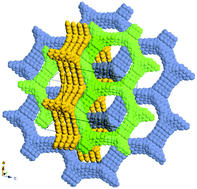Abstract
1,3,5-Tris(4-carboxyphenyl)benzene assembles into an intricate 8-fold polycatenated assembly of (6,3) hexagonal nets formed through hydrogen bonds and π-stacking. One polymorph features 56 independent molecules in the asymmetric unit, the largest Z′ reported to date. The framework is permanently porous, with a BET surface area of 1095 m2 g−1 and readily adsorbs N2, H2 and CO2.


 Please wait while we load your content...
Please wait while we load your content...